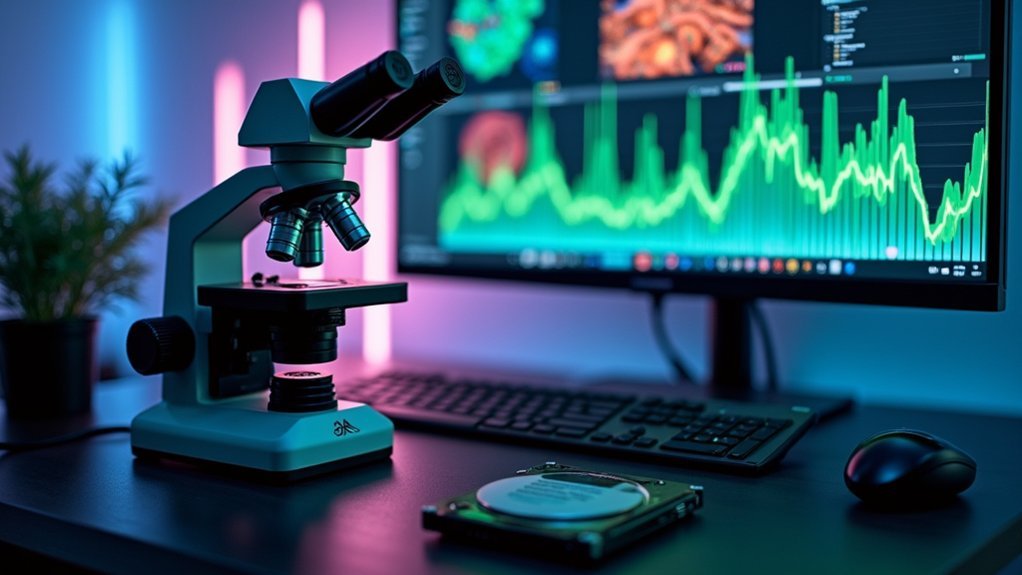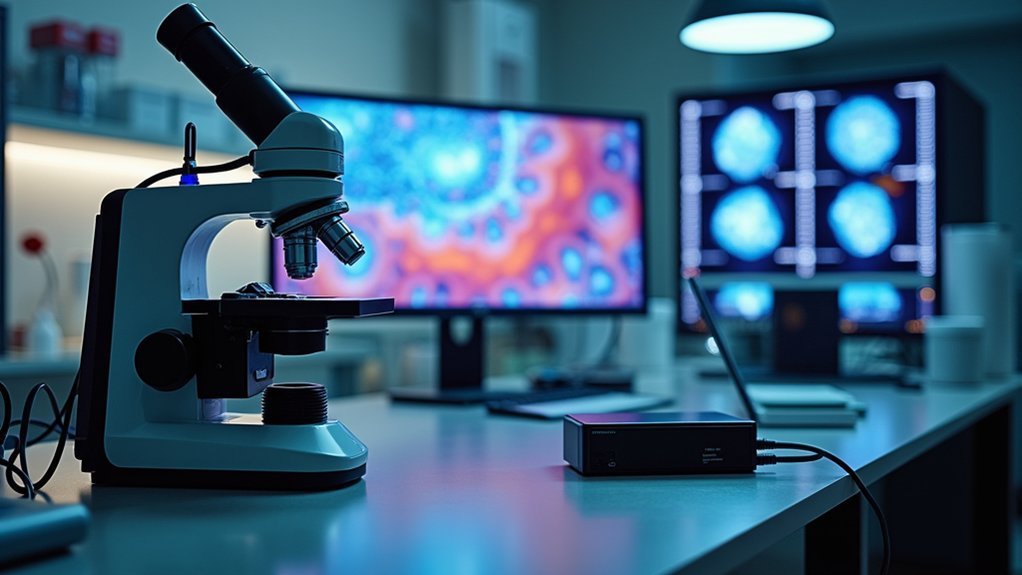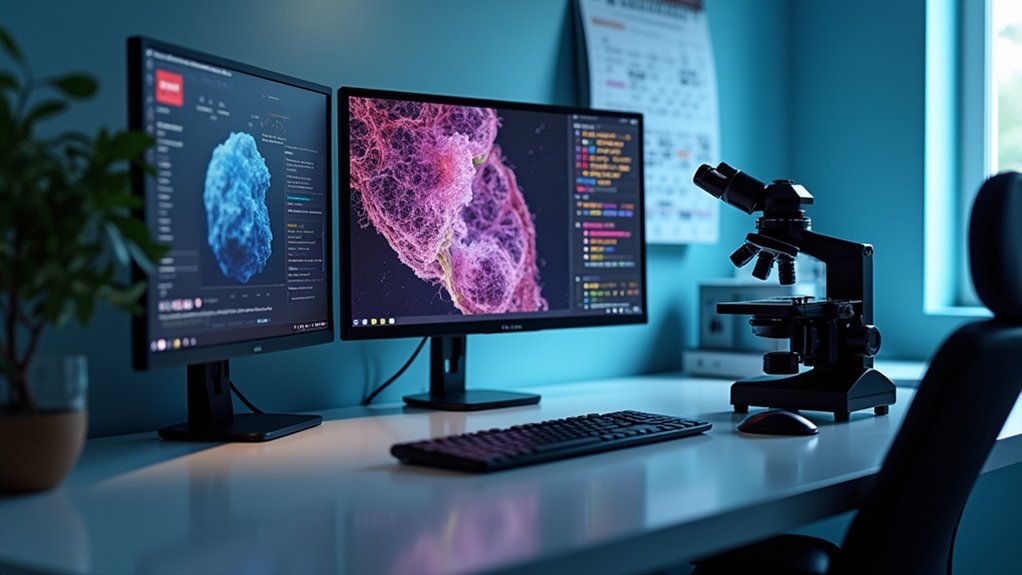For efficient live microscopy data storage, save directly to designated data drives (D:/) rather than C:/ drives. Transfer data immediately after acquisition sessions using USB3 external drives (up to 180 MB/s) or NICdata servers (100 MB/s). Implement consistent file naming conventions and a hierarchical folder structure (Lab/Year/Project/Experiment). Regular backups are essential as sessions can generate 20-200+ GB. Proper hardware selection and metadata preservation will transform your imaging workflow from chaotic to streamlined.
Store Live Microscopy Data: Complete Storage Setup Guide

When setting up storage for live microscopy, you’ll need to implement a systematic approach to manage the substantial data generated during each session.
Always save directly to designated data drives (D:/) rather than the C:/ drive to prevent space issues with your system files.
Make sure you move all original data from acquisition computers immediately after your session, as these machines aren’t designed for long-term storage and may automatically delete files when space runs low.
This is especially important when working with proprietary file formats that could exceed 200 GB per session.
Create folders labeled with your full name or netID, and utilize LMCF’s temporary storage for inter-departmental transfers.
Consistent file naming conventions will save you significant time when retrieving specific datasets later.
Understanding File Size Challenges in Live Microscopy
Your live microscopy experiments can quickly generate overwhelming data volumes, with single sessions producing anywhere from 20 GB to over 200 GB depending on your imaging parameters.
You’ll face significant bottlenecks when hardware components like disk write speeds can’t keep pace with the data stream from multi-channel, time-lapse, or multi-position acquisitions.
Setting up appropriate storage solutions requires understanding these gigabyte growth factors, particularly how adding dimensions like z-stacks, channels, or time points exponentially increases your file sizes.
Gigabyte Growth Factors
The sheer magnitude of data generated during live microscopy sessions presents significant storage challenges for researchers. Your data sets can rapidly expand from 20 GB to over 200 GB in a single session, depending on your imaging parameters.
Consider how quickly files multiply: a single 4 MP sCMOS image (8.3 MB) becomes a 373.5 MB z-stack with 15 planes and 3 channels.
Add time-lapse imaging with 15 time points, and you’re handling 5.6 GB. Include 5 positions, and that balloons to 28 GB.
Your transfer capabilities also affect workflow—NIC microscopes with gigabit Ethernet can move data at 100 MB/s, while UCSF computers may be limited to 10 MB/s.
Always keep a copy of critical data and implement consistent naming conventions to maximize available storage space.
Hardware Speed Bottlenecks
Beyond generating massive data sets, the hardware components in your live microscopy workflow can create important bottlenecks that impede research progress.
Data transfer speeds are critically affected by your system’s hardware limitations, which can dramatically impact your experimental timeline.
While gigabit Ethernet connections on modern NIC microscopes transfer data at approximately 100 MB/s, older systems might struggle at just 10 MB/s.
Your choice of external storage also matters greatly—USB3 drives can achieve up to 180 MB/s, while USB2.0 drives typically max out at 20-30 MB/s.
These differences become vital when moving multi-gigabyte files from your microscope to analysis workstations.
Implementing efficient data management strategies requires careful consideration of these hardware constraints to avoid unnecessary delays in your imaging workflow.
Essential Data Management Principles for Research Labs

Establishing robust data management practices is critical before you begin generating microscopy data, as poor organization can quickly lead to chaos when handling thousands of images.
Store your files in a designated folder on the data drive with your full name or netid for quick identification.
Your data management strategy should include:
- A consistent file naming convention that makes retrieval intuitive as your image collection grows
- Regular backups using a structured folder architecture (Lab/Year/Project/sub-project/experiment/replicates/files)
- Prompt deletion of local copies after confirming backups, as acquisition computers aren’t safe for long-term storage
Best Practices for Temporary Storage on Acquisition Computers
You’ll need to manage your temporary storage on acquisition computers carefully, as files may be deleted after just one week if space is needed for other experiments.
Save your microscopy data directly to the designated data drive (D:/) rather than the C:/ drive to maintain proper organization and prevent unnecessary space usage.
After confirming successful backup to the server, delete your local copies promptly to free up space for other users and request extended storage options from LMCF staff if your project requires it.
Time-Limited Storage Guidelines
While acquisition computers provide convenient temporary storage for your microscopy data, they aren’t designed for long-term data preservation.
You’ll need to use the designated data drive (D:/) rather than local drives like C:/ when saving your files. Remember that temporary storage is only allowed for a maximum of one week, after which files may be deleted without warning if space is needed.
- Create a folder with your full name or netID on the data drive for easy organization
- Delete local copies after confirming your data is properly backed up
- Consider creating a simple text file inventory of your data to track what you’ve transferred
Prompt data transfer from acquisition computers is essential—these systems aren’t safe for long-term storage and shouldn’t be relied upon beyond immediate use.
Server Access Protocol
Beyond the one-week storage limit, proper server access procedures are essential for safeguarding your microscopy data.
When working with live microscopy, you’ll need to save directly to the designated data drive (D:/) rather than the C:/ drive on the acquisition computer, making sure your files remain accessible while preventing system overload.
Create clearly labeled folders with your full name or netid for even a single image capture. It would be nice to organize related files together for easier retrieval later.
Remember to promptly transfer your data to a departmental server or external drive once your session ends.
For temporary server share access during large transfers, contact LMCF staff beforehand to arrange proper permissions and resources tailored to your specific experimental needs.
Establishing Effective File Naming Conventions

How often have researchers found themselves lost in a sea of cryptically named files months after completing their microscopy experiments? Implementing a robust naming convention from the start will save you countless hours and frustration as your image collection grows.
Adopt a standardized format like “Lab_Year_Project_Subproject_Experiment_Replicate” to guarantee consistency across all files. This structure provides immediate context for each image file.
- Avoid spaces and special characters that can cause compatibility issues across different software platforms.
- Include essential metadata in filenames such as acquisition settings and sample descriptions.
- Review and update your naming conventions periodically to accommodate new research directions.
Setting Up Organized Folder Structures for Easy Retrieval
Once you’ve established solid file naming conventions, the next essential step is creating an organized folder structure that scales with your research.
Begin with a hierarchical system like Lab/Year/Project/sub-project/experiment/replicates/files that provides clear context and facilitates retrieval as your data volume grows.
Label each folder with descriptive metadata to quickly identify contents without opening files. Create dedicated sub-folders that separate raw data, processed results, and analyses to maintain workflow clarity. This separation prevents accidental overwriting and establishes logical progression through your data pipeline.
Don’t treat your folder structure as static. Schedule regular reviews to reorganize as your research evolves.
Adapting your architecture to new projects guarantees you’ll always find what you need, even years after acquisition.
Secure Data Transfer Methods Between Systems

You’ll achieve ideal transfer speeds by leveraging gigabit Ethernet connections on NIC microscopes, which deliver approximately 100 MB/s compared to standard 100 megabit connections.
For external media transfers, choose USB3 drives offering up to 180 MB/s rather than the notably slower USB2 options limited to 20-30 MB/s.
Your lab can also integrate with the NICdata server for local transfers or utilize UCSF-provided Box accounts through MyAccess for unlimited cloud storage solutions.
Network Transfer Options
Efficient data transfer between systems represents a critical component of successful live microscopy workflows.
When moving your large microscopy datasets, you’ll need to choose the appropriate network option based on your specific requirements.
- NIC microscopes with gigabit Ethernet connections deliver impressive 100 MB/s transfer speeds—10× faster than standard 100 megabit connections found on most UCSF computers.
- For local transfers within the network, utilize the NICdata server for reliable handling of large datasets without external hardware.
- When external storage is necessary, prioritize USB3 drives (up to 180 MB/s) over USB2 drives (20-30 MB/s), but verify compatibility with your system ports.
For cloud-based transfers, your UCSF MyAccess Box account supports unlimited file sizes, providing secure off-site storage and transfer capabilities.
External Drive Solutions
Three essential options exist for secure external drive solutions in live microscopy workflows.
First, utilize USB3 external drives for efficient data transfer at speeds up to 180 MB/s—nearly six times faster than USB2.0 drives’ 20-30 MB/s capability. This difference is vital when handling large microscopy datasets.
For system-to-system transfers, verify your NIC microscopes support gigabit Ethernet connections, which deliver approximately 100 MB/s transfer rates—ideal for maintaining data integrity during live sessions.
Before connecting any external drive, confirm hardware compatibility to prevent transfer interruptions.
The NICdata server offers a reliable local transfer alternative when moving substantial datasets without internet constraints.
Implement regular backups with clear file naming conventions to guarantee easy data retrieval and protect against unexpected data loss.
Lab Server Integration
When implementing lab server integration for live microscopy, selecting the right data transfer method dramatically impacts workflow efficiency. Your connection type determines how quickly you’ll move large datasets between systems.
Gigabit Ethernet connections on NIC microscopes transfer data at approximately 100 MB/s, while standard UCSF computers with 100 megabit connections are limited to just 10 MB/s.
For ideal integration, consider:
- Using the NICdata server for local transfers to streamline the process and maintain data integrity
- Connecting via USB3 external drives when possible, achieving speeds up to 180 MB/s—significantly faster than USB2.0 alternatives
- Verifying port compatibility with your external drives to prevent transfer issues and maintain efficient workflow
Always match your transfer method to your dataset size to minimize downtime between acquisition and analysis.
Long-Term Storage Solutions for Microscopy Datasets

Maintaining effective long-term storage for microscopy datasets requires thoughtful planning beyond simply saving files. Implement clear naming conventions that will make sense years later as your image collection grows. This foresight guarantees you’ll locate specific datasets efficiently when needed.
Adopt a structured folder hierarchy (Lab/Year/Project/sub-project/experiment/replicates/files) to organize your data systematically. Remember to regularly back up everything to prevent catastrophic loss.
Consider implementing Omero as a central management platform for storing both images and their associated metadata. This approach prevents complications from proprietary file formats that might become inaccessible with future software changes.
Periodically review and update your organizational strategy to address retrieval challenges. These proactive measures will guarantee your valuable microscopy data remains accessible and usable for years to come.
Preserving Metadata and File Format Considerations
The critical metadata embedded in proprietary microscopy file formats represents a double-edged sword for researchers. While these formats contain essential information about acquisition settings, they’re often incompatible with analysis software you’ll need later.
You must establish practices that preserve this metadata alongside your raw images.
- Export metadata separately as text files or spreadsheets when proprietary formats are unavoidable.
- Implement consistent file naming conventions that allow quick identification of experiment parameters.
- Create a hierarchical folder structure (Lab/Year/Project/sub-project/experiment/replicates/files) to organize growing datasets.
Remember to schedule regular backups of both your images and metadata. This redundancy guarantees you won’t lose critical experimental conditions even if original files become corrupted or software compatibility issues arise in the future.
Hardware Requirements for Efficient Data Processing
Successful live microscopy depends heavily on your hardware infrastructure’s ability to handle the massive data streams generated during imaging sessions. Equip your systems with high-speed NIC microscopes featuring gigabit Ethernet connections that transfer data at 100 MB/s to process large datasets efficiently.
For data transfer, opt for USB3 external drives that achieve speeds up to 180 MB/s—substantially faster than USB2.0 drives’ 20-30 MB/s rate. This dramatically reduces file transfer times for your imaging experiments.
Ensure your computational setup includes sufficient RAM and processing power, particularly when working with stitched images or 3D volumes.
Implement a structured folder architecture (Lab/Year/Project/sub-project/experiment/replicates/files) to streamline data organization as your collection grows, and maintain regular backups to prevent catastrophic data loss.
Frequently Asked Questions
How Can I Automate Data Migration Between Temporary and Long-Term Storage?
You can automate data migration using scheduled scripts, workflow management tools, or dedicated software that moves files based on age or criteria you’ve set between your temporary and long-term storage systems.
Are Cloud Storage Solutions Reliable for Microscopy Data Backups?
Yes, cloud storage is reliable for microscopy data backups. You’ll benefit from redundancy, automatic versioning, and remote access. However, you should still maintain local copies and consider bandwidth limitations for large datasets.
How Do I Estimate Future Storage Needs for Expanding Research Projects?
Calculate your storage needs by multiplying current monthly data volume by project duration and growth factor. You’ll want to assess image resolution requirements, anticipated sample numbers, and add 30% buffer for unexpected needs.
Which Compression Algorithms Minimize Data Loss for Microscopy Files?
For microscopy files, you’ll want lossless compression algorithms like JPEG2000, JPEG-LS, or PNG to minimize data loss. These preserve image quality while reducing file size, unlike lossy methods that sacrifice detail.
Can Different Team Members Use Shared Naming Conventions Effectively?
Yes, you’ll find shared naming conventions highly effective for team collaboration. When everyone uses consistent labels for files, you’ll reduce confusion, improve searchability, and guarantee smoother workflows between different team members.
In Summary
By implementing proper storage practices for your live microscopy data, you’ll not only protect your valuable research but also streamline your workflow. Remember to manage temporary storage carefully, establish consistent naming conventions, and invest in appropriate long-term storage solutions. Don’t neglect metadata preservation—it’s essential for data integrity. With these systems in place, you’re well-equipped to handle even the most data-intensive microscopy projects.





Leave a Reply